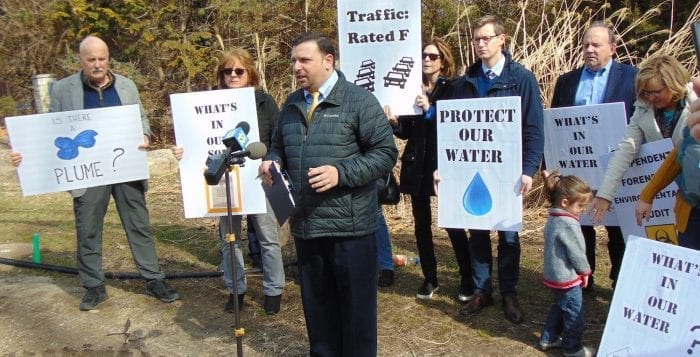Residents Raise Concerns About Gyrodyne Sewage Treatment Plant Proposal
The Suffolk County Sewer Agency will meet June 22 to discuss granting provisional approval of plans to construct a Sewage Treatment Plant on the Gyrodyne property, Route 25A in St. James. The STP would be in the watershed of Stony Brook Harbor, a major source of the North Shore’s clean water supply. Based on testimony from independent environmentalists and water quality experts, we believe building this STP presents serious health, safety and environmental concerns affecting residents of the towns of Smithtown, Brookhaven and across the North Shore of Long Island. We caution the Sewer Agency not to act hastily without full review of environmental and health impact studies.
Six Reasons the Gyrodyne Sewage Treatment Plant Should Not be Built in its Proposed Location
1. Biohazard and medical waste usage requirements. Medical and health care facilities — two primary tenants of the proposed Gyrodyne redevelopment — pose special sewage-treatment needs, including advanced filtration systems to safely process radioactive and biohazardous medical waste products. However, toxicity and other special needs have not been addressed in the approval process. In fact, a 2012 study by the Stony Brook University School of Marine and Atmospheric Sciences cited the unexpectedly high level of radioactive iodine in Stony Brook Harbor traced to effluent from Stony Brook Hospital.
2. Noncompliance with government laws and regulations. Under New York State’s Environmental Quality Review Act, the conditional approval being considered by the SC Sewer Agency is premature and illegal. As a subordinate agency in the SEQRA process, Suffolk County can only provide approvals after SEQRA is complete and accepted by the permitting authority (in this case, the Town of Smithtown). Smithtown has not completed the process.
3. Instant overcapacity. The proposed STP is slated to accept 100,000 gallons per day for treatment. Gyrodyne officials have stated their intention of allowing Lake Avenue (St. James) business district to hook up to the STP adding another 70,000+ gallons per day. The Lake Avenue sewage volume would immediately put the plant above overcapacity.
4. Location. Sited in a Rapid Groundwater Transport area less than 8,000 feet upstream from Stony Brook Harbor, the proposed plant will discharge thousands of gallons of effluent daily into grounds abutting the harbor — and ultimately seep into the harbor itself, killing off the ecosystem.
5. Waterway vulnerability. Stony Brook Harbor is a relatively narrow waterway with meager flush capacity taking up to 12 days for full water exchange with Long Island Sound. In addition, due to the unique configuration of Smithtown Bay, waste products will remain for exceptionally long periods in the harbor until finally removed by the tidal exchange.
6. Nitrogen exposure. Suffolk County Executive Steve Bellone (D) has named nitrogen “Public Enemy #1,” calling it Suffolk County’s largest cause of water quality degradation. Nitrogen is associated with marine hypoxia and habitat destruction leading to excessive algae blooms and “green water syndrome.” As nitrogen cannot be fully filtered from effluent flow, permitting construction of this STP on Gyrodyne property would dramatically undermine the county’s $4 billion campaign to reduce nitrogen exposure
We urge the Suffolk County Sewer Agency to wait until the New York State’s Environmental Quality Review Act is complete or, better yet, recommend a more appropriate location for what is quickly becoming a regional sewer treatment plant on environmentally sensitive lands.
George Hoffman, Co-founder, Setauket Harbor Task Force
Executive Board, Three Village Civic Association
Cindy Smith, Greater Stony Brook Action Coalition







